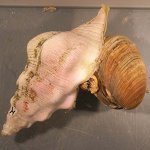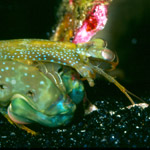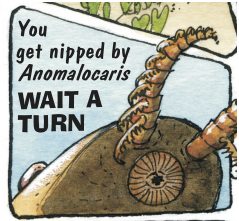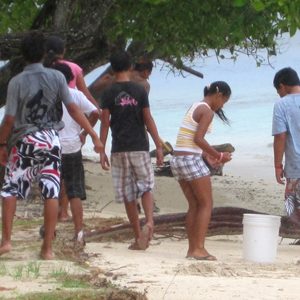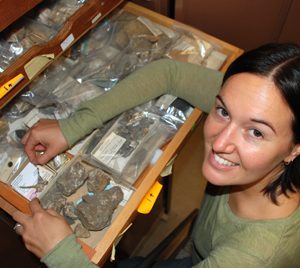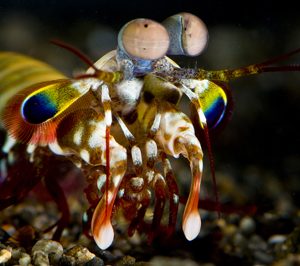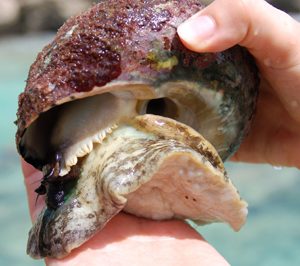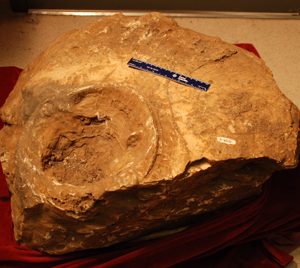If you study snails, you’ve got to be patient. But two UCMP graduate students, Jann Vendetti and Scott Fay, used time-lapse photography to kick slow snails into high gear. They discovered some surprising behavior in snails living today—and in snails that lived millions of years in the past. The video features snails of two species: Kelletia kelletii, and Busycotypus canaliculatus (also known as Busycon canaliculatum). This group of animals is so numerous and diverse—in lifestyle, natural … [Read more...] about Paleo Video: Snail shell mystery
invertebrates
Even a mantis shrimp is what it eats
Ask most anyone what butterflies use their wings for or what fish do with their fins and you will undoubtedly hear an answer like, "Wings are used for flying and fins are used for swimming!" Some body parts just seem so well-adapted to perform certain functions; this is why there is a paradigm in biology that "specialized" body parts correspond to specific ways in which animals go about their daily business. In other words, specialization in morphology corresponds to specialization in ecology. … [Read more...] about Even a mantis shrimp is what it eats
The game of prehistoric life
Evolve or Perish is a new board game – not from the makers of Monopoly, but from ETE, the Evolution of the Terrestrial Ecosystems Program, at the Smithsonian National Museum of Natural History. UCMP Faculty Curators Cindy Looy and Ivo Duijnstee designed the game in collaboration with illustrator Hannah Bonner. Hannah is well-known for her cartoon paleobooks When Bugs Were Big and When Fish Got Feet. The three enjoy collaborating -- Hannah created the logo for Cindy's lab's web site, and she is … [Read more...] about The game of prehistoric life
Middle schoolers and marine biodiversity in Moorea
Scientists from institutions like the UCMP travel all around the world and interact with many local communities. Last year the Berkeley Natural History Museums launched a project called the GK-12 Moorea fellowship to foster collaboration between graduate students and local communities in Moorea, French Polynesia. The program sends one graduate student to Moorea, a small island about 10km from Tahiti, to teach interactive science lessons in public schools and do ecological research. As the … [Read more...] about Middle schoolers and marine biodiversity in Moorea
Creatures from the black lagoon
Very little was known about wetland ecology back in 1869, when Samuel Merritt dammed a former tidal slough and began developing its surrounding wetland as his "Jewel of Oakland." By restricting the flow of waters in and out of the newly created tidal lagoon, a.k.a. Lake Merritt, silt and algae were allowed to accumulate and within a few years the lake had become a bit of an environmental disaster. Nevertheless, part of it was designated by Teddy Roosevelt as our nation's first wildlife refuge, … [Read more...] about Creatures from the black lagoon
No backbones allowed
The UCMP Invertebrates Collection includes over 31,000 catalogued specimens! Corals, crabs, bivalves, snails, ammonites… both fossil and recent — if it doesn't have a backbone, it's in this collection. I am a UCMP and Integrative Biology graduate student and have been assisting with curation of the Invertebrate Collection. I catalogue and label specimens, process loan requests, manage the Invertebrates Collection database, curate private collections that are donated to the UCMP, and do numerous … [Read more...] about No backbones allowed
Stomatopods and DVDs
Sometimes, the study of basic biology can lead to technological advances, and a recent discovery about the vision of mantis shrimp is a perfect example, providing insight that could help us improve the technology inside DVD players. What is the connection? Circularly polarized light! You're probably familiar with linearly polarized light. Fishermen often wear polarized sunglasses to reduce the glare from the water and make it easier to see the fish. Typically a ray of light vibrates randomly in … [Read more...] about Stomatopods and DVDs
A summer studying snails in the Caribbean
I am a graduate student with the UCMP and the Department of Integrative Biology at Berkeley, and I study the biogeography, conservation biology, and microevolution of molluscs. From July through August of 2009, I traveled to nine islands in the Eastern Caribbean looking for Cittarium pica, a large, marine gastropod, or snail. This species has many common names, including West Indian Topshell, burgao, burgos, cingua, magpie shell, wilke, and “whelk”, which is why knowing the scientific name is so … [Read more...] about A summer studying snails in the Caribbean
Rudists
Not to be rude, but what in the world is a rudist? Well, rudists are invertebrates, and they lived in the world’s oceans during the late Jurassic and the Cretaceous, about 150-65 million years ago; they are now extinct. They are bivalves — the name means “two shells.” Today’s familiar bivalves, clams and mussels, have two shells that are more or less symmetrical. But rudists were a bit unusual: their two shells were very different from each other. One shell was either conical or coiled, … [Read more...] about Rudists
